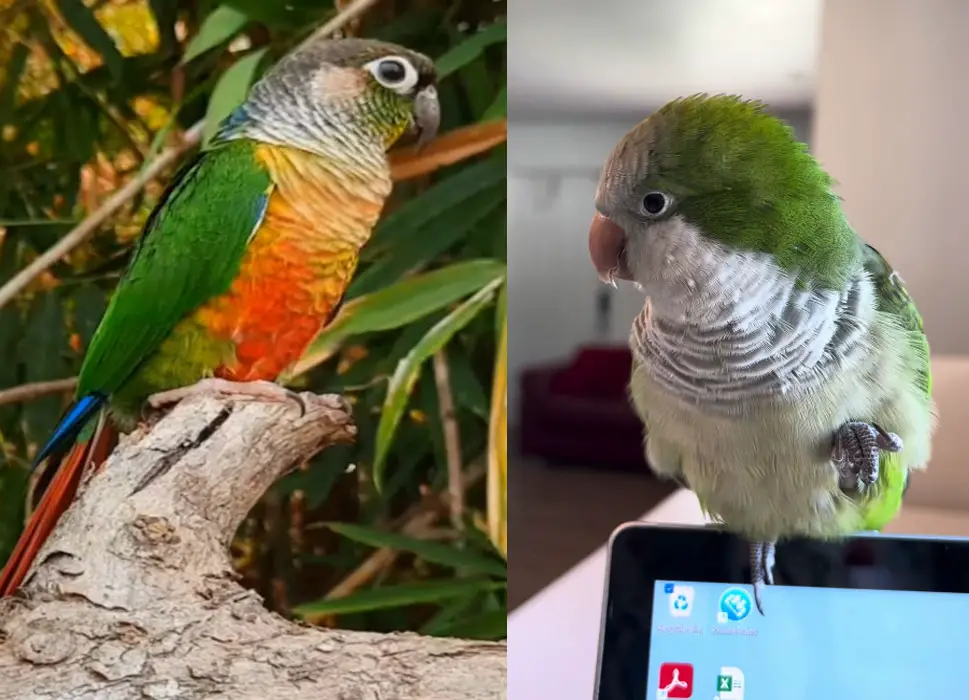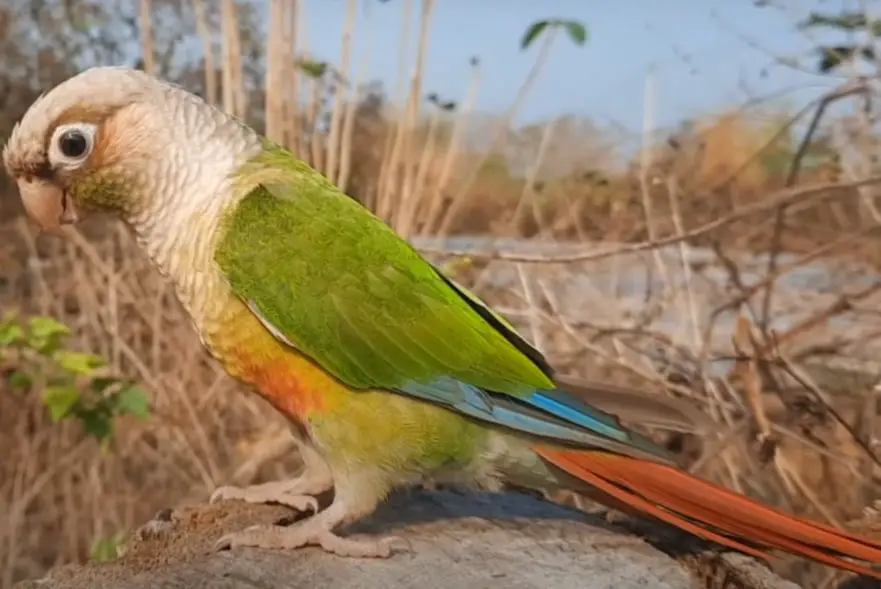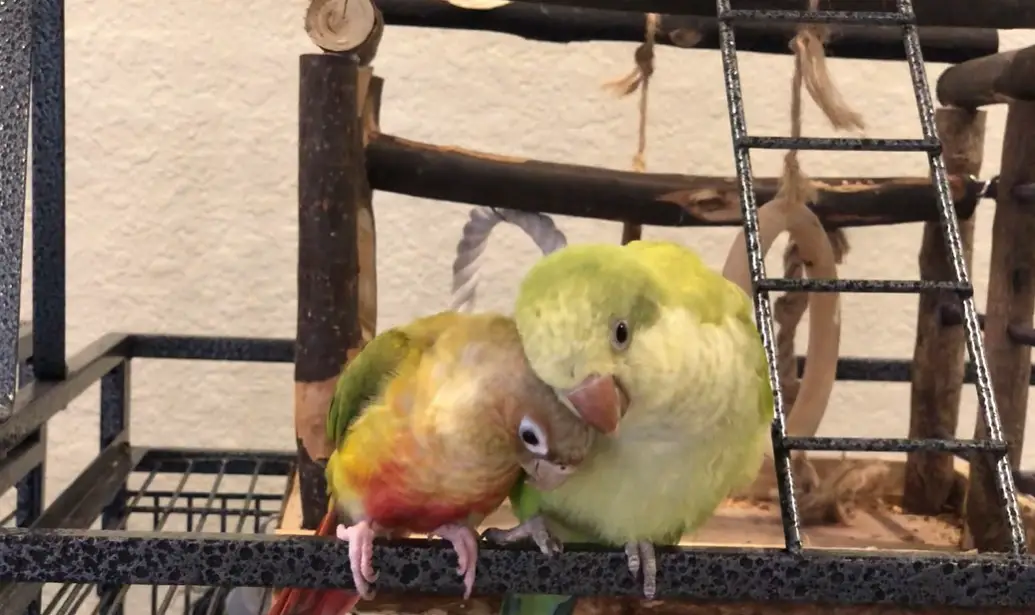Quaker Parrot vs Green Cheek Conure: Differences and Similarities
Choosing between two birds has always been a nightmare for me. Most of the time, I end up getting both because they are just so freakin cute. I’ve never been a great chooser, but I help other people to choose between two birds.
Just a few days ago, one of my friends came to me about selecting between the Quaker parrot and Green Cheek Conure. As I already have both these birds in my home, I told him what things he should be concerned about while getting these parrots.
One of my answers is as follows: Green Cheek Conures are more active and affectionate; therefore, they need more time and love than Quaker Parrots. So, if you’re someone with a busy schedule, then Quaker Parakeet is the right way to go.
Similar to this, there are several other things you need to know before choosing between these two parrots. So, take your time and check out the individual differences between the birds. It should help you in making your decision.
Key differences between Quaker parrots and Green Cheek Conures:
| Characteristics | Quaker parrot | Green Cheek Conure |
|---|---|---|
| Behavior | Independent, playful, affectionate | Social, affectionate, playful |
| Intelligence | Highly intelligent, trainable | Highly intelligent, trainable |
| Talking ability | Impressive vocabulary | Can learn to talk, but not as skilled |
| Personality | Playful, Affectionate, cuddly, mischievous | Playful, Affectionate, cuddly, mischievous |
| Food | Pellets, fresh fruits and vegetables, occasional treats | Pellets, fresh fruits and vegetables, occasional treats |
| Maintenance and care | Daily cleaning of cage, fresh food and water, regular vet visits | Daily cleaning of cage, fresh food and water, regular vet visits |
| Noise level | Loud, high-pitched calls sometimes will drive you nuts. | Loud, high-pitched calls, flock call is a must do thing. |
| Biting issue | May nip or bite when threatened or uncomfortable | Without any reason it bites |
| Cage aggression | Territorial, may become aggressive | Generally not cage aggressive |
| Cuddly | Very affectionate and cuddly | Very affectionate and cuddly |
| Cage size | Larger cage needed, at least 36*36 inches | Medium size cage need, but at least 24*32 inches. |
Quaker Parrot Vs. Green Cheek Conure: The Better Feathered Friend
I’ve lined up the basic similarities and differences between the two birds. However, note that each individual parrot is different and can come with different qualities.
For instance, some Green Cheeks learn to talk, whereas most of them don’t. So, the differences I included here might not be true to the Parakeet you’re getting.

About Their Personalities
Honestly, both these birds have almost the same personalities. Their behavioral patterns are so similar in some cases that it will be almost impossible for the inexperienced eye to find the difference.
Both the Quaker Parrot, aka Monk Parakeet, and Green Cheek Conure are friendly, sociable, energetic, and fun-loving birds. These birds can create a strong bond with their owner and will remain loyal if not neglected.
Anyways, I have used the word ‘almost,’ not the word ‘entirely.’ So, it means there are some differences in their characteristics.
Quaker Parakeets have a distinctive behavioral feature. It can only be seen in these birds. They quake and bob in a very weird way, which looks a little disturbing and abnormal.
Despite how unnatural it might seem, it is a common action for Quaker parrots. So, don’t get flabbergasted if you see your Monk Parakeet quaking and bobbing.
Green Cheek Conures, on the other hand, doesn’t have such behavioral features. Instead, they act like a clown and are often full of energy. You will see them hanging upside down inside their cages or clamoring along the bars to draw the attention of their owners.
From what I’ve seen, Green Cheek parrots are more energetic and playful than Quaker Parakeets. However, both breeds require a lot of attention and love, or else they might become neurotic or depressed.
Their Colors and Sizes
Most of you who are familiar with Quaker parrots should know that these birds come in a variety of colors. The most common Quaker Parakeets are green (wild color) or blue (blue mutation) from the head, wings, and back and have gray-colored throat and chest.
These parrots also come in green-gray, pastel, cinnamon, yellow (lutino quaker parrots), and white (albino quaker parrots) colors.
Green Cheek Conures, on the other hand, don’t come in completely different colors; instead, they feature a mutation of colors. The typical Green Cheek Conure has a maroon tail, a bright green body, and gray barring on its chest. You will see a bit of red shades on its belly as well.

In any case, Green Cheek Conures come in a few different mixtures of colors. For instance, there are pineapple, yellow-sided, cinnamon, turquoise, mint, and high-red Green Cheek Conures. However, all the other colors are difficult to find on the market.
Green Cheek Conures tend to be slightly smaller than Quaker parrots. The former is 10 inches in length on average, whereas Quaker Parakeets are usually 12 inches in length.
So, if you already have a small cage or want to keep a small bird as a pet, then go with Green Cheek Parakeets, or else you can opt for Quaker parrots.
Which One Speaks Better?
I will have to side with Quaker parrots on this one. So, I had both Parakeets, and from what I’ve seen, it’s easier to teach Quaker parrots to speak. Green Cheek Conures also can learn to talk, but it is not seen as often as you will see with the former.
So, there is a good chance your Green Cheek parrot might not learn to speak at all, and even if it does, it may not be very clear. Monk Parakeets, on the other hand, are great speakers and can learn a lot of words and phrases.
Their speech is clearer than the one of Green Cheek Conure. So, if you’re looking for a parrot that you can easily train to speak, then it’s better to get a Quaker Parakeet.
Food Habit and Diet
Well, both birds have a similar food habit, which includes fruits, veggies, seeds, and pellets. One thing to remember while feeding birds is that you should never give them avocados. It is like poison to them, so keep it as far away as possible from them.
Quaker parrots are not very selective eaters. They will eat almost anything you throw at them. In fact, they tend to lose control while eating, which eventually causes them to become obese.
Quaker parrots are prone to liver diseases and obesity, so you need to be extra careful while preparing a diet plan for them.
Green cheeks don’t have the same issue. However, you shouldn’t feed them fruit seeds.
Noisy Neighbor!
Quaker parrots are known to be extremely noisy. My Quaker parrot used to scream its heart out in the morning and evening till it learned how to speak words. These birds make a lot of noise, and sometimes it can get unbearable.
Green Cheeks, on the other hand, are much quieter compared to Quaker birds. It’s not like they don’t make any sound. Green Cheeks will scream without any reason. Especially when they need attention.
My one screams, well, when excited, bored, not bored, needs attention, does not need attention and I want to scream because I want to! But it is much more tolerable than Quaker parrots.
For both species, flock call is a must doing things!
So, if you live in an apartment where your neighbors might complain about the excessive sound, then there are better choices than Quaker Parakeet. In such cases, you should opt for Green Cheek Conures.
However, if noise isn’t something you’re concerned about, then you can go for a Monk Parakeet.
The Bigger the Bird, The Harder It Bites
Both Quaker parrot and Green Cheek Conure are known to bite. However, they bite when they feel threatened or scared. If you can create a strong bond with your birds, then it is highly likely they will stop biting for good.
In any case, Quaker parrots are slightly larger than Green Cheek Conures. So, you can expect that the former will have a stronger biting force than the latter. However, it is relatively easy to train these birds and stop them from biting. But Green Cheeks are much more prone to biting! Without any reason it bites!
Sometimes, your pet Quaker or Green Cheek might bite your finger playfully. I would advise you not to encourage such behavior because if they get the idea that biting is not wrong, then they are likely to bite even more in the future.
Do They Pluck Feathers?
Feather plucking is a dominant issue with most birds, and the same goes for the Quaker and Green Cheek parrots. Both Monk and Green Cheek Parakeets are known to pluck feathers for several reasons.
First of all, you need to make sure they’re not bored or neurotic. You need to keep them entertained with toys and by giving them your time. If neglected, both these birds will start to pluck feathers.
If entertainment isn’t the issue, then it’s probably because of diet, allergies, toxins inside the house, or bacterial diseases.
Cuddle Buddies
Well, both parrots are known to cuddle with their owners; however, it depends a lot on the upbringing and training of the bird. A poorly trained or neglected Quaker parrot will not even come close to any human, much less cuddle them. The same goes for Green Cheeks.
However, with proper upbringing and training, these birds can become very affectionate towards their human buddies. So, it’s possible to make these parrots your cuddle buddies, but you might need to be patient for a while.
Potential Risks to Your Health
Although I have never been a victim of diseases from birds, I have heard that in some cases, people do fall sick due to bird diseases.
According to the Centers for Disease Control and Prevention or CDC, people may develop Psittacosis from birds such as parrots, ducks, turkeys, and cockatiels. The disease is called avian chlamydiosis when it affects birds.
It usually spreads through the respiratory secretions and droppings of infected birds.
However, if you maintain a clean environment for the birds and keep them in regular checkups, then the chances of you or your parrots getting infected will reduce significantly. So, you know what to do.
Child Safety
One of the biggest concerns of any pet or bird owners is the safety of their children. I’ve come across many people asking me which of these birds are safer for kids.
Well, both parrots can be great loving friends with proper training. However, as mentioned, Green Cheeks are smaller, and from what I’ve heard, they are less aggressive than Quaker parrots. But they are more nippy!
With a little patience from your side, you can easily teach these birds to adapt to grownups and children. But, if you ask me, I would not recommend any parrot for children. I just do not prefer bird near my children.
Cage Aggression
Quakers may show cage aggression, especially during mating season or when hormones strike. Another reason is, Quakers are only parrots that build nests. hence they are much more likely to show cage aggression.
On the other hand, Green Cheeks are not known to be cage aggressive. But they may show aggression during mating season or when hormones strike. Hormones do mysterious thing to pet birds!
Your Time is Important
As I’ve said before, both Quaker and Green Cheek Parakeets require a tremendous amount of affection, time, and caring. If you neglect them, they’ll start to get violent, aggressive, neurotic, and even depressed.
Obviously, you’ll need to buy toys to keep them busy and entertained; however, without regular interaction, you might lose the bond. Quaker parrots need a lot of toys, or else they will channel their energy to your valuables.
Green Cheeks, on the other hand, are highly affectionate birds; therefore, they need a significant amount of time out of the cage. If I have to compare, then I would say Green Cheek Conures require more time and affection than Quaker Parrots do.
Wrapping Up!
There is no better or worse when it comes to a Quaker Parrot and a Green Cheek Conure. In the end, it boils down to your preference, your schedule, and your lifestyle. Both Quaker Parakeet and Green Cheek are loyal and loving companions. They are certain to keep you on your toes.
I’ve given you every detail, starting from their personalities to how much noise they make. It should be enough for you to draw out the pros and cons and come to a conclusion. Hope you’ve found everything you were looking for. Good Luck with your future endeavors.
